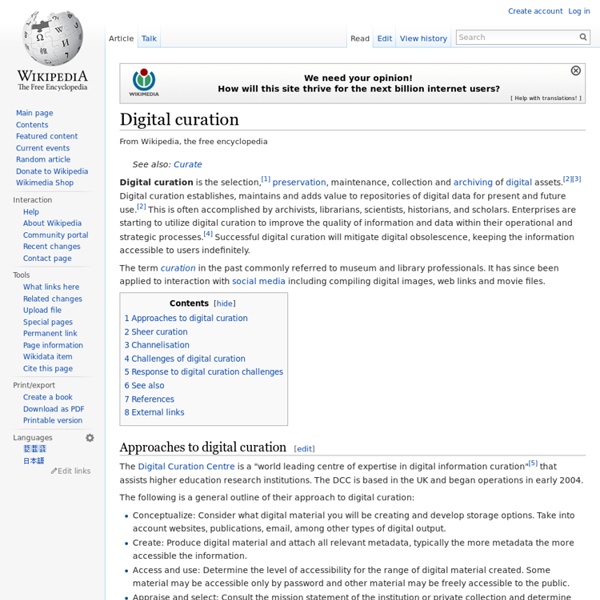Let’s Brainstorm with Mobile Devices! 15+ Free Apps for IOS/Android
Posted by Shelly Terrell on Friday, March 29th 2013 Part of the Mobile Learning Series! “You can have brilliant ideas, but if you can’t get them across, your ideas won’t get you anywhere.” – Lee Iacocca quotes Brainstorming is an important process that helps improve writing, organizes group ideas, inspires discussion, and provides a roadmap for projects.
Software as a service
According to a Gartner Group estimate, SaaS sales in 2010 reached $10 billion, and were projected to increase to $12.1bn in 2011, up 20.7% from 2010.[6] Gartner Group estimates that SaaS revenue will be more than double its 2010 numbers by 2015 and reach a projected $21.3bn. Customer relationship management (CRM) continues to be the largest market for SaaS. SaaS revenue within the CRM market was forecast to reach $3.8bn in 2011, up from $3.2bn in 2010.[7] The term "software as a service" (SaaS) is considered to be part of the nomenclature of cloud computing, along with infrastructure as a service (IaaS), platform as a service (PaaS), desktop as a service (DaaS), backend as a service (BaaS), and information technology management as a service (ITMaaS). History[edit]
Content Curation: Bringing Order to Information Overload
By Christy Barksdale | Posted | 16 Comments | Filed in: Content Marketing Content marketing, the publishing of relevant, link-worthy content, has been all the rage for marketing professionals for several years. A recent survey conducted by content marketing authority Junta42 shows that companies, especially small businesses, are continuing to spend more on content marketing each year because it is more effective than traditional marketing for differentiation in the marketplace. Leads, sales and client retention are better achieved when companies are resources for their customers and help solve their pain points. Now, the new wave of content marketing has arrived: content curation. What is content curation?
Content Curation
Content Curation is the process of sorting through vast amounts of web and enterprise based content and presenting it in an organized and meaningful format. An individual who performs this activity is known as a content curator. When training organizations are responsible for providing intellectual or knowledge-based content through an online means of delivery, such as a learning portal, the information that is published must be aggregated, sorted and displayed in a relevant and usable way.
Goal 10: Spread Your Knowledge (15+ Tools to Bookmark, Aggregate, Curate)
Goal 10 of The 30 Goals Challenge for Educators! Click the link to find out more about the new changes to this year’s 30 Goals Challenge for Educators! ““If you have knowledge, let others light their candles in it. ” ~ Margaret Fuller Short-term– share resources you have collected about a topic with colleagues at school or online.
Social networking service
A social networking service (also social networking site or SNS) is a platform to build social networks or social relations among people who share interests, activities, backgrounds or real-life connections. A social network service consists of a representation of each user (often a profile), his or her social links, and a variety of additional services. Social network sites are web-based services that allow individuals to create a public profile, to create a list of users with whom to share connections, and view and cross the connections within the system.[1] Most social network services are web-based and provide means for users to interact over the Internet, such as e-mail and instant messaging. §History[edit] The most popular social networking sites by country Early social networking on the World Wide Web began in the form of generalized online communities such as Theglobe.com (1995),[15] Geocities (1994) and Tripod.com (1995).
What is Content Curation?
What is Content Curation? Content Curation is the act of discovering, gathering, and presenting digital content that surrounds specific subject matter. Though it is still considered a "buzz word" by many in the content world, content curation is now becoming a marketing staple for many companies with a successful online presence. Unlike content marketing, content curation does not include generating content, but instead, amassing content from a variety of sources, and delivering it in an organized fashion. For instance, a content curator is not necessarily responsible for creating new content, but instead, for finding relevant content pertaining to a specific category and funneling this information to readers in a mash-up style.
4 Reasons Why Content Curation Has Gone Mainstream
Guest post written by Pawan Deshpande Pawan Deshpande is CEO of Curata. With the help of Pinterest and other consumer-oriented companies, content curation - the process of finding, organizing and sharing online content – has gone mainstream. More and more people are looking to content curation to help them navigate today’s chaotic online world. But it’s not only consumers that are benefitting.
Learning about Visual Notetaking from Giulia Forsythe
<div class="greet_block wpgb_cornered"><div class="greet_text"><div class="greet_image"><a href=" rel="nofollow"><img src=" alt="WP Greet Box icon"/></a></div>Hello there! If you are new here, you might want to <a href=" rel="nofollow"><strong>subscribe to the RSS feed</strong></a> for updates on this topic.<div style="clear:both"></div></div></div> (cross-posted from PlayingWithMedia.com)
Feedly
§History[edit] In November, 2006, Edwin Khodabakchian co-founded DevHD.[3] The company seeks to create a platform that uses RSS feeds, online storage, and social media integration to connect users with the information they find interesting.[3] DevHD’s first project, Streets, which aggregates updates from a variety of online sources is the basis of Feedly. Feedly, which was optimized for RSS feeds, was first released on June 15, 2008.[3] Originally called Feeddo, Feedly was first released as a web extension before moving onto mobile platforms.[4]



